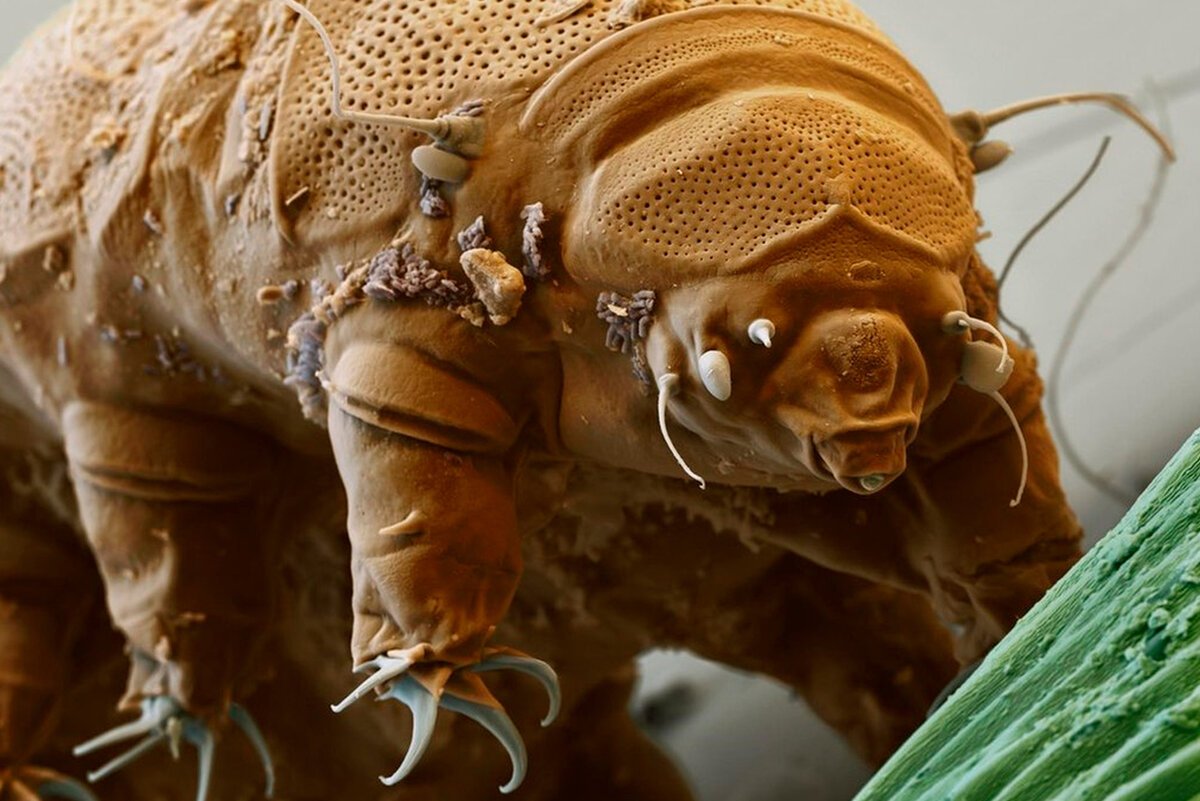The tardigrade was first discovered in 1773 by German zoologist Johann August Ephraim Geze. These are invertebrates, among which there are both aquatic and terrestrial species. They reproduce with the help of eggs laid by a female, in an amount from 1 to 30. A slow–moving, sometimes called a water bear, is a microscopic creature capable of withstanding the most extreme conditions on Earth. Their genetic makeup can provide important information about the survival and evolution of organisms. And now we will look at the characteristics and adaptations of slow walkers that make them so tenacious, as well as potential biotechnological applications that may result from their scientific research.
The tardigrade is microscopic and slow, but no other animal has such superpowers as it! The tardigrade is a real superhero, which is why scientists have begun to actively study its properties. It is very tiny (from 0.05 mm to about 1.2 mm in length), and yet this invertebrate, whose name means “slow-moving animal", seems indestructible.
She will not die either by inhaling toxic gases or by exposure to radiation that is harmful to any other living being, including humans. Moreover, it can survive an asteroid impact that will destroy all life on Earth. This aquatic animal (the Anglo-Saxons call it a water bear) can live anywhere and in any climate, be it frost or temperature, which will incinerate any person.

Características y adaptaciones de la criatura más viviente del mundo
The tardigrade has developed a number of adaptations to withstand extreme pressure, low temperatures, radiation and dehydration. These creatures are able to enter a state of anhydrobiosis, almost death, in which they are completely dehydrated, thereby reducing their metabolism. In this state, they can survive a temperature of -458 degrees Fahrenheit, a pressure of 6000 atmospheres and ionizing radiation.
The adaptation of the tardigrade is not limited to its ability to extreme survival. This creature also has a number of unique structures, such as stilettos, which allow it to stick to surfaces and move easily on them. In addition, it is able to accumulate glycoproteins that protect it from radiation, thereby preventing DNA damage.
A tardígrade is a small creature whose body consists of a head and four “metameres” (segments), each of which has a pair of legs with nails. There are vegetarian, carnivorous and even cannibalistic species, but they are all “eutelic”: that is, they have the same number of cells throughout their lives, and when an individual grows, its cells increase in volume, but not in quantity.
Of more than a thousand species of tardigrades, those called Hypsibius dujardini and Ramazzottius varieornatus have... an additional upgrade. When the environment is arid, they produce substances (proteins) that prevent damage to their cells, even if deprived of water. Then they “turn off”, that is, they fall into a kind of absolute lethargy, which reduces vital functions to a minimum, and can remain in this state, without food and water, even for decades, until the environment becomes acceptable again for their awakening.
Tardigrade and its potential biotechnological application in scientific research
Due to their extraordinary resilience, these babies are able to provide important information about the survival and evolution of organisms. Studying these organisms can also help scientists develop new materials and technologies that are resistant to extreme conditions.
In addition, they can be used as models in developmental biology, since their cells are easy to observe under a microscope. This can help scientists better understand the processes of embryonic development, cell differentiation and tissue regeneration.
Finally, the abilities of tardigrades can be used in biotechnology, for example, in the field of cryopreservation. Their ability to tolerate dehydration and low temperatures can be used to preserve cells, tissues and organs, facilitating long-distance transportation and long-term storage.

The DNA that was stolen…
The secret of the superpowers of this “crumbs” lies in their DNA system, which transmits information about the characteristics of the species to subsequent generations. They can get parts of DNA from other organisms living in harsh conditions, for example, from bacteria,” says Thomas Boothby, a biologist at the University of North Carolina (USA). “So they could adopt some of their 'tricks' for survival.”
In fact, there are other animals capable of incorporating parts of other species' DNA into their own DNA, but none of them, except the water bear, has been able to make such progress in stealing. 17 percent were borrowed from other species. That's why knowing about the unusual capabilities of slow walkers can lead to some explosive discoveries. For example, to the possibility of drying vaccines against diseases and storing them for a long time at room temperature, rather than freezing in liquid nitrogen, as it has to be done now.
And again, studying the wonders of nature, even the wonders of small water bears, can help us live better! In conclusion, it should be noted that the tardigrade is an amazing creature, very useful for scientific research. Its extraordinary resilience opens up many opportunities for the development of new technologies and materials. Research can also help to better understand the evolution and survival of organisms. Ultimately, this is an extraordinary example of extreme life adaptation and biological resistance.


 and then
and then 
